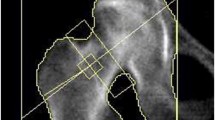Abstract
Purpose
Our aim was to estimate the in vivo reproducibility of bone mineral density (BMD) at dual-energy X-ray absorptiometry (DXA) and to compare fast array, array, and high-definition scan modes.
Materials and methods
A total of 378 patients (38 males and 340 females; mean age 63 ± 9 years) underwent DXA using a QDR-Discovery A densitometer (Hologic). Considering the three scan modes on lumbar spine and right femur, six independent groups of 30 patients were examined twice (for a total of 180 patients). Least significant change (LSC) and smallest detectable difference (SDD) were calculated. The remaining 198 patients underwent three scans of the lumbar spine (n = 92) or of the right femur (n = 106), one for each scan mode. The student t test and Bland–Altman analysis used were. Scan times were recorded and radiation dose was estimated using the ICRP60 method.
Results
Intra-scan mode reproducibility was 98–99 %, corresponding to an LSC of 1.49–2.08 %. The SDD was 0.018–0.023 g/cm2 (lumbar spine) and 0.017–0.019 g/cm2 (right femur). All comparisons among scan modes were statistically significant (p < 0.001) but lower than SDDs, i.e. not clinically relevant. Considering lumbar spine and the right femur, scan times were 50 and 38 s for fast array, 98 and 74 s for array, and 195 and 148 s for high definition, respectively; radiation doses were 6.7 and 4.7 μSv for fast array, and 13.3 and 9.3 μSv for both array and high definition, respectively.
Conclusion
Since all BMD differences were lower than the SSDs, the three scan modes can be considered interchangeable. As a consequence, although the absolute reduction in time and radiation dose is relatively low, when BMD measurement is the aim of DXA, fast array can be generally preferred.
Similar content being viewed by others
References
Njeh CF, Fuerst T, Hans D et al (1999) Radiation exposure in bone mineral density assessment. Appl Radiat Isot 50:215–236
Lewiecki EM, Gordon CM, Baim S et al (2008) International Society for Clinical Densitometry 2007 Adult and Pediatric Official Positions. Bone 43:1115–1121
El Maghraoui A, Guerboub AA, Achemlal L et al (2006) Bone mineral density of the spine and femur in healthy Moroccan women. J Clin Densitom 9:454–460
Baim S, Wilson CR, Lewiecki EM et al (2005) Precision assessment and radiation safety for dual-energy X-ray absorptiometry: position paper of the International Society for Clinical Densitometry. J Clin Densitom 8:371–378
Bland JM, Altman DG (1986) Statistical methods for assessing agreement between two methods of clinical measurement. Lancet 1:307–310
No authors listed (1991) 1990 Recommendations of the International Commission on Radiological Protection. Ann ICRP 21:1–201
No authors listed (1993) Consensus development conference: diagnosis, prophylaxis and treatment of osteoporosis. Am J Med 94:646–650
Blake GM, Fogelman I (2007) The role of DXA bone density scans in the diagnosis and treatment of osteoporosis. Postgrad Med J 83:509–517
Sardanelli F, Di Leo G (2008) Biostatistics for radiologists. Springer, Milan, pp 165–179
El Maghraoui A, Achemlal L, Bezza A (2006) Monitoring of dual-energy X-ray absorptiometry measurement in clinical practice. J Clin Densitom 9:281–286
Conflict of interest
Michele Bandirali, Luca M. Sconfienza, Alberto Aliprandi, Giovanni Di Leo, Daniele Marchelli, Fabio M. Ulivieri, Francesco Sardanelli declare no conflict of interest.
Author information
Authors and Affiliations
Corresponding author
Rights and permissions
About this article
Cite this article
Bandirali, M., Sconfienza, L.M., Aliprandi, A. et al. In vivo differences among scan modes in bone mineral density measurement at dual-energy X-ray absorptiometry. Radiol med 119, 257–260 (2014). https://doi.org/10.1007/s11547-013-0342-3
Received:
Accepted:
Published:
Issue Date:
DOI: https://doi.org/10.1007/s11547-013-0342-3




